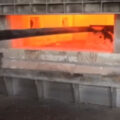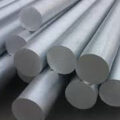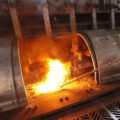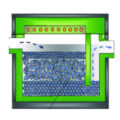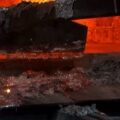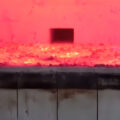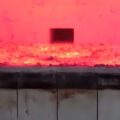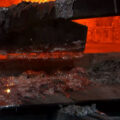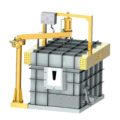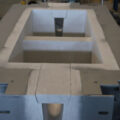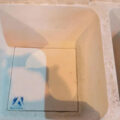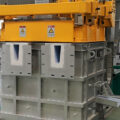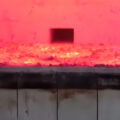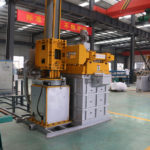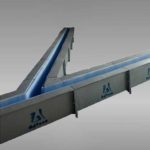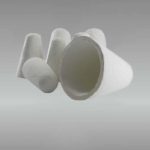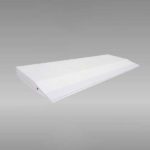Filtering method for molten aluminum is based on the principle that the iron-rich phase impurities in the aluminum alloy melt are segregated at a lower temperature and a longer holding time, and mechanical filtration is used to remove the aggregated iron-rich phase materials. The filtering iron removal method is generally carried out during the melt casting. It can not only remove the large iron-rich phase substances, but also the colleagues can remove other large-sized inclusions in the aluminum and aluminum alloy melts. The filtering method for molten aluminum usually uses ceramic foam filter.
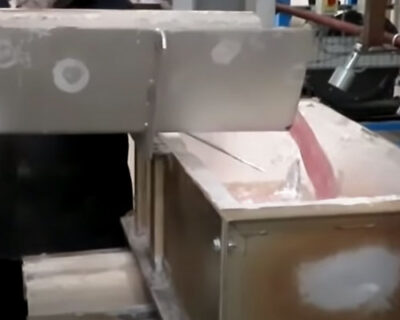
The production process of secondary aluminum alloy can be divided into three stages: pretreatment, smelting (including refining), and ingot casting. The smelting process is to add scrap aluminum into the smelting furnace and heat it to melt into a liquid state. After slagging, temperature measurement and composition The inspection and other processes are transferred to the refining furnace, where elements such as silicon and copper are added, and the process of degassing, slag removal and refining is carried out. The harmful metal elements in the secondary aluminum melt mainly include Fe, Mg, Zn, Pb, etc., and different removal methods are required for different harmful metal elements.
Iron is a common magazine in the production of secondary aluminum, which has an extremely adverse effect on the quality and performance of aluminum and aluminum alloys. Therefore, in addition to the pretreatment of the scrap aluminum to remove iron, the inclusion of iron should be removed as much as possible during the smelting process to prevent it from being slightly dissolved in the aluminum and aluminum alloy melt. Generally, the following methods are used to remove iron inclusions.
Manganese and iron removal method
Manganese can effectively form a high melting point iron-rich phase compound in the aluminum alloy solution and deposit on the bottom of the furnace to achieve the purpose of iron removal. The amount of manganese used to remove 1kg of iron is 6.7-8.3kg, and it can transform the remaining coarse flake, hard and brittle Al9Fe2Si2 phase into the flake AlSiMnFe phase, thereby weakening the harmful effects of iron. However, the method of adding manganese to remove iron will increase the manganese content of the aluminum alloy. Aluminum alloys with limited manganese content should not be used, and the cost of the method of adding manganese to remove iron is higher.
Beryllium addition method
Beryllium reacts with the Al9Fe2Si2 phase in the aluminum alloy melt, thereby reducing the harmful effects of iron. Adding 0.05%—0.1% of beryllium to aluminum and aluminum alloy melts can promote the transformation of the coarse and flake-shaped Al9Fe2Si2 phase into dot-shaped Al5BeFeSi, which obviously eliminates the brittleness of aluminum alloy. However, the price of beryllium is relatively high, and beryllium vapor is toxic, harmful to the human body, and pollutes the working environment. Therefore, the method of adding beryllium to iron should be used with caution.
Settling iron removal method
The sedimentation iron removal method is the comprehensive effect of a multi-element master alloy prepared with four substances of Mn, Cr, Ni and Zr, which interacts with the coarse iron-rich compound in the aluminum alloy melt to form a new multi-element iron-rich compound. The multi-element iron-rich compound gradually grows up with the decrease of temperature. When it grows up enough to overcome the settlement resistance, it will settle, thereby removing iron. When the amounts of Mn, Cr, Ni, and Zr are 2.0%, 0.8%, 1.2%, and 0.6%, respectively, the iron content in the aluminum and aluminum alloy melts treated by the sedimentation iron removal method can be reduced from 1% To 0.2%. Manganese plays a major role in removing iron in the sedimentation method. Although chromium is not as good as manganese in removing iron, it has better resistance to oxidation and burnout. The main purpose of adding nickel is to reduce the brittleness caused by manganese and chromium residues. In addition to the role of iron, the addition of zirconium also has the role of grain refinement.
Filtering method for molten aluminum
The method of filtering iron usually uses foam ceramic filter. Ceramic foam filter has the advantages of high strength, erosion resistance, strong adsorption capacity, and effective removal of tiny inclusions in aluminum liquid. Installed in the filter box for aluminum alloy liquid impurity filtration, to meet the production of high value-added, high-tech performance aviation, transportation and other aluminum alloy precision casting.

Smelting direct iron removal method
The direct iron removal method by smelting has been widely used in the secondary aluminum industry due to its low cost and simple operation. The method is briefly described as follows:
(1) Strictly control the melting temperature, use the difference between the melting points of aluminum and iron to melt the aluminum, and iron and other high-melting metal impurities settle to the bottom of the furnace to remove the iron. The inclined rotary kiln can efficiently process various waste aluminum Smelting furnace for processing.
(2) During smelting, iron debris should be removed before each stirring, and iron mixed in aluminum slag should be taken out during slag removal.
(3) According to the actual conditions of the selected smelting equipment and technology, in principle, the slag and iron deposited on the bottom of the furnace should be pulled out for every batch of aluminum waste smelted.
(4) When a secondary aluminum enterprise uses a smelting furnace-holding furnace for production, after each furnace is melted, the molten aluminum in the furnace is dispatched to remove the iron in a hot state.
(5) Using rapid melting, low temperature aluminum tapping. During smelting, the recycled aluminum scrap is quickly smelted under the protection of solvent, and the entire melting process is about 2-3 hours. When the recycled aluminum scrap is melted, the temperature of the melt is about 650°C. At this temperature, the solubility of iron in aluminum and aluminum alloy melts is extremely small. At this time, the iron contained in the recycled aluminum scrap remains in the slag and is clear with the slag.

